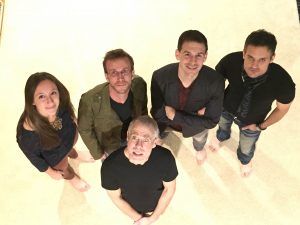SDSU Symphony’s New Music of the Night
Conceptually, the encounter of composer Joseph Martin Waters’ virtuoso avant-garde performance ensemble Swarmius with a symphony orchestra suggested a blazing science fiction movie rather than a sedate concert piece.
For the record, Waters’ “Suite Noir,” which was given its premiere Sunday (March 22) by the San Diego State University Orchestra and five Swarmius soloists, fell into neither category. In this expansive, three-movement 30-minute work, Waters’ stepped back from his usual adventurous harmonic structures and careening electronic overlays to craft a jazzy concerto grosso that also included a prominent role for a vocal soloist.The consistent Waters trademark, however, is his eclectic elision of genres and styles. Setting up the vocalist as narrator against a turbulent orchestra suggested Schoenberg’s monodrama “Erwartung,” while the function of the virtuoso instrumental soloists suggested one of J. S. Bach’s “Brandenburg” Concertos.
In Waters’ verbal program notes before the performance, he described his intention to pay homage to American jazz and popular vocal music of the mid-20th century. That desire brought in the harmonic palette of the jazz greats Ellington and Dorsey, which he beautifully embodied in moody saxophone solos—executed with consummate finesse by Michael Couper—doubled and decorated by the shimmer of Andrew Kreysa’s vibraphone artistry.
And what better way to invoke Hollywood’s golden age of noir than the croon of a saxophone?
Waters’ “Suite Noir” was indeed sweet noir.
Vocalist Emma DePuy dominated the opening movement, using her creamy mezzo and sophisticated phrasing to paint Waters’ dreamlike nocturnal scene (the text can be found in the program below). Over a relaxed orchestral pulse, Waters provided her an angular arioso line that alluded to the arch conversational style of Kurt Weill’s songs from his American stage works. One Touch of Venus perhaps?
Waters’ middle movement began as a stormy orchestral scherzo that fiercely engaged the orchestra’s string and percussion sections, launched by violinist Isaac Allen’s bold opening salvo. After another round of Kreysa’s vigorous, incisive vibraphone figurations, Couper’s bluesy sax line slowed down the pace to allow DePuy to summon the break of dawn with gentle vocal ruminations.
“Suite Noir” ended with a frenzied dance that evoked ecstatic dervishes and gave fervid solos for each soloist, including pianist Karen Follingstad. Conductor Michael Gerdes successfully guided his orchestra through the many challenges of the new score. At their best, he made his players sound like a plush studio orchestra from motion pictures’ golden age.
Gerdes opened the SDSU Symphony’s program with Aaron Copland’s iconic noir opus “Quiet City,” featuring trumpeter John Wilds and English Horn soloist Sarah Skuster. Each soloist plays with the San Diego Symphony and serves on the SDSU music faculty, and each gave this piece the deftly restrained lyrical quality Copland intended for his moody work.
Although I have attended other events in SDSU’s Montezuma Hall at the new Conrad Prebys Student Union, this is the first time I have heard a concert presented in it. A large, high-ceilinged room, Montezuma Hall’s acoustics were friendly enough for an orchestra concert, although without a shell behind the players, the ensemble lacked some focus deeper in the seating area. But it is a promising venue.

Ken Herman, a classically trained pianist and organist, has covered music for the San Diego Union, the Los Angeles Times’ San Diego Edition, and for sandiego.com. He has won numerous awards, including first place for Live Performance and Opera Reviews in the 2017, the 2018, and the 2019 Excellence in Journalism Awards competition held by the San Diego Press Club. A Chicago native, he came to San Diego to pursue a graduate degree and stayed.Read more…

